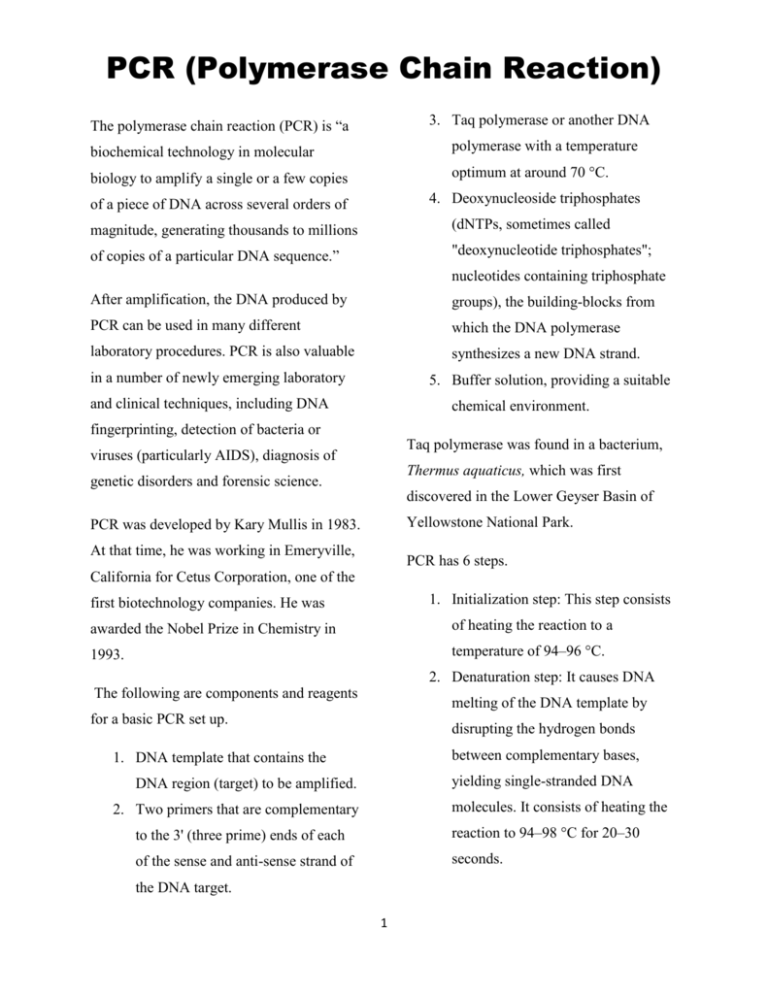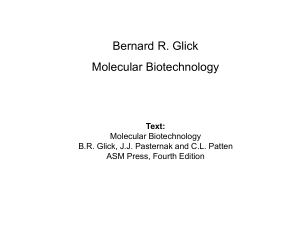PCR (Polymerase Chain Reaction)
advertisement

PCR (Polymerase Chain Reaction) 3. Taq polymerase or another DNA The polymerase chain reaction (PCR) is “a biochemical technology in molecular polymerase with a temperature biology to amplify a single or a few copies optimum at around 70 °C. of a piece of DNA across several orders of 4. Deoxynucleoside triphosphates magnitude, generating thousands to millions (dNTPs, sometimes called of copies of a particular DNA sequence.” "deoxynucleotide triphosphates"; nucleotides containing triphosphate After amplification, the DNA produced by groups), the building-blocks from PCR can be used in many different which the DNA polymerase laboratory procedures. PCR is also valuable synthesizes a new DNA strand. in a number of newly emerging laboratory 5. Buffer solution, providing a suitable and clinical techniques, including DNA chemical environment. fingerprinting, detection of bacteria or Taq polymerase was found in a bacterium, viruses (particularly AIDS), diagnosis of Thermus aquaticus, which was first genetic disorders and forensic science. discovered in the Lower Geyser Basin of Yellowstone National Park. PCR was developed by Kary Mullis in 1983. At that time, he was working in Emeryville, PCR has 6 steps. California for Cetus Corporation, one of the 1. Initialization step: This step consists first biotechnology companies. He was awarded the Nobel Prize in Chemistry in of heating the reaction to a 1993. temperature of 94–96 °C. 2. Denaturation step: It causes DNA The following are components and reagents melting of the DNA template by for a basic PCR set up. disrupting the hydrogen bonds between complementary bases, 1. DNA template that contains the yielding single-stranded DNA DNA region (target) to be amplified. molecules. It consists of heating the 2. Two primers that are complementary to the 3' (three prime) ends of each reaction to 94–98 °C for 20–30 of the sense and anti-sense strand of seconds. the DNA target. 1 PCR (Polymerase Chain Reaction) 3. Annealing step: The reaction temperature is lowered to 50–65 °C for 20–40 seconds allowing annealing of the primers to the single-stranded DNA template. The polymerase binds to the primertemplate hybrid and begins DNA formation. 4. Extension/elongation step: The temperature at this step depends on the DNA polymerase used; Taq Fig 1. Diagram of PCR polymerase has its optimum activity temperature at 72°C. Under optimum Now PCR is so essential in the conditions at each extension step, the biotechnological field that the amount of DNA target is doubled, biotechnological industry cannot leading to exponential (geometric) exist without PCR. amplification of the specific DNA fragment. 5. Final elongation: This single step is occasionally performed at a temperature of 70–74 °C for 5–15 minutes after the last PCR cycle to ensure that any remaining singlestranded DNA is fully extended. 6. Final hold: This step at 4–15 °C for an indefinite time may be employed Fig 2. Thermocycler of PCR for short-term storage of the reaction. 2










